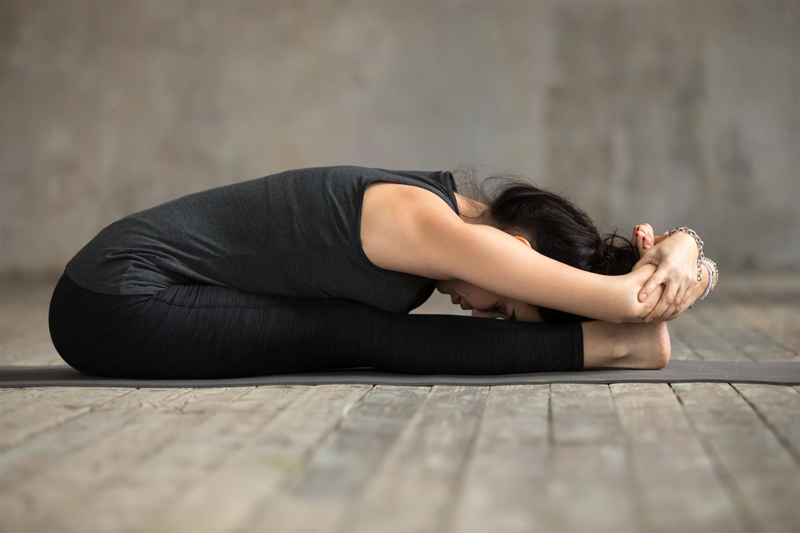A slow-paced style of yoga, Yin Yoga focusses on physical asanas. In Yin Yoga, the postures are held for a longer duration than they are in other styles; beginners are advised to hold each position for around two minutes, while more advanced yogis are encouraged to hold the stretch for five minutes. As the asanas are held for an extended period of time, practitioners are advised to wear flexible yoga pants to each session. In this article, we explore Yin Yoga in more detail.
History and Origins
Yin Yoga was founded by Taoist Yoga instructor, Paulie Zink, in the late 1970’s. Zink’s style incorporates the full range of Taoist yoga and is considered a complete yoga form in its own right. However, Yin Yoga classes that use both Yin and Yang are hard to come across in the West. Instead, many studios use the techniques associated with the style to complement more active forms of exercise. This combination was first introduced by Yin Yoga instructors Paul Grilley and Sarah Powers but is now used in yoga studios worldwide.
Benefits of Yin Yoga
When practised correctly, Yin Yoga brings with it a host of great health benefits. Specifically, the practice works with the yin tissues in the body. These are more commonly referred to as the connective tissues. This type of muscle responds best to slow movement, which is why Yin Yoga encourages practitioners to hold the asanas for longer. Gently stretching the tissue for an extended period of time will start to build flexibility and strength.
Yin Yoga can also remove blockages from the myofascial meridians. Over time, energetic obstructions can build up in the connective tissue. If left untreated, various symptoms may start to appear such as tightness, pain, and discomfort. Yin Yoga uses a series of asanas to stimulate and cleanse these areas, ultimately removing the blockages.
In addition to benefiting your physical health, Yin Yoga can have a positive effect on your emotional health, too. When the connective tissue is stretched, small gaps are created. Many practitioners believe that these spaces allow suppressed emotions to make their way to the surface. Ultimately, this will encourage the body to let go of unpleasant memories, emotions, and thoughts, and leave space for positive feelings to develop in their place. During a Yin Yoga session, instructors will encourage students to let go of negative energy; once they have done so, students should focus on observing what type of emotions arise in the space. If unpleasant memories surface, students should try to recognise these feelings, but not identify with them. This will guide the body into releasing the emotions instead of suppressing them once more. Storing negative emotions uses a high level of energy, so releasing them can improve both your mental and physical health.
Poses for beginners
Butterfly Pose
Butterfly Pose is often practised within Yin Yoga classes. To begin, sit comfortably on your yoga mat. Next, use your hands to grab both feet and draw them together. The soles of your feet should now be touching. Bring your feet as close to your crotch as possible, without stretching further than your body is capable of. Keep your feet in this position but move your hands onto your knees. Gently begin to press your knees and thighs into the ground to increase the stretch. You are in Butterfly Pose. Beginners should aim to hold the asana for around two minutes, while more advanced practitioners should remain in place for five. If the posture becomes uncomfortable, release the stretch and move onto something different.
Melting Heart
To practice Melting Heart Pose, begin on all fours in a tabletop position. Next, slowly walk your hands forward until your arms are fully extended. Your forearms should now be resting comfortably on the mat. When you’re ready, gently bring your head between your shoulders and rest your forehead on the ground. If completely extending your arms feels uncomfortable, try bending your elbows and rest only your forearms on the mat. If you use this position, bring your palms together as if you are praying. You are in Melting Heart Pose. Hold the posture for a few minutes whilst breathing deeply. As this asana is intense on the shoulders, it’s important to adjust your form if necessary.
Sphinx Pose
To practice Sphinx Pose, lay down with your stomach touching the mat. Next, use your forearms to prop yourself up – this movement works to open your chest. Hold this position for a few seconds before pressing down into the ground to straighten your arms. At this point, you can either bow your head or keep it in line with the rest of your spine. There is no right or wrong way to practice this asana, so just choose whichever option feels more comfortable for you. You are in Sphinx Pose. Hold the posture for a few minutes whilst trying to relax. When you’re ready to release the stretch, try holding a neutral spine for a few seconds before getting up.
In Summary
This slow-paced style of yoga can be practised by yogis of all sorts. If you’re a complete beginner, it’s im-portant not to push yourself too far. Aim to hold each posture for one minute to start with, gradually in-creasing the duration as you become more comfortable. To ensure you are holding the asanas correctly, it may be worth attending a local class rather than practising independently. There, an experienced instructor will be able to guide you through each technique. When practising Yin Yoga, it’s important to be comfortable. Wearing a lightweight top and a flexible pair of yoga pants is probably your best bet.

